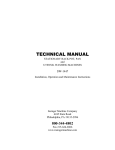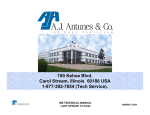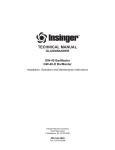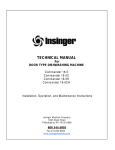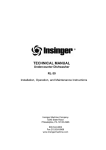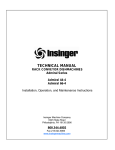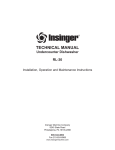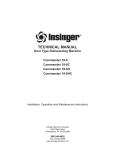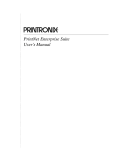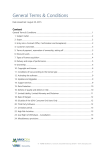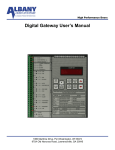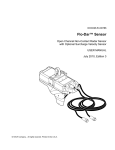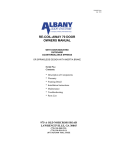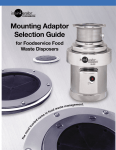Download Tech Manual
Transcript
TECHNICAL MANUAL STATIONARY RACK POT, PAN and UTENSIL WASHING MACHINES SW-36-F Installation, Operation and Maintenance Instructions Insinger Machine Company 6245 State Road Philadelphia, PA 19135-2996 800-344-4802 Fax 215-624-6966 www.insingermachine.com Thank you for purchasing this quality Insinger product. On the space provided below please record the model, serial number and start-up date of this unit: Model:__________________________________ Serial Number:___________________________ Start-Up Date:____________________________ When referring to this equipment please have this information available. Each piece of equipment at Insinger is carefully tested before shipment for proper operation. If the need for service should arise please contact your local Authorized Insinger Service Company. A Service Network Listing is provided on our web site, www.insingermachine.com or call Insinger at 800-344-4802 for your local authorized servicer. For proper activation of the Insinger Limited Warranty a SureFire™ Start-Up & Check-Out Service should be completed on your machine. Refer to the Introduction section in this manual for an explanation of Insinger SureFire™ Start-Up & Check-Out Program. Please read the Insinger Limited Warranty and all installation and operation instructions carefully before attempting to install or operate your new Insinger product. To register your machine for warranty by phone, fax or the internet or for answers to question concerning installation, operation, or service contact our Technical Services Department: TECHNICAL SERVICE CONTACTS Toll-Free 800-344-4802 Fax 215-624-6966 e-mail [email protected] Web site www.insingermachine.com 2 DOC SW‐36‐F 2.2010 www.insingermachine.com Table of Contents Table of Contents Warranty Specifications Electrical Data Breakdown Warnings and Cautions Introduction Installation Instructions Start‐Up Procedures Sequence of Operation Operation of Machine Preventive Maintenance Trouble Shooting ¬Electric Machine Trouble Shooting ¬Gas Machine Trouble Shooting ¬Steam Machine Parts List Drawings: General View General View – Extra High Four View: ¬Electric Wash Heat Four View: ¬Gas Wash Heat Four View: ¬Electric Wash Heat – Extra High Door Weight and Cable Assembly Bun Pan Rack Cake Pan Rack Wash System Drain System Rack and Screen Location Electric Wash Heat ¬Control Circuit Ladder Diagram Gas or Steam Wash Heat ¬Control Circuit Ladder Diagram Electric Wash Heat ¬Control Circuit Schematic with 700 cfm Fan Gas and Steam Wash Heat ¬Control Circuit Schematic with 700 cfm Fan Trouble Shooting Flowchart 3 4 6 7 8 9 10 13 15 15 17 19 20 20 21 25 26 27 28 29 30 31 32 33 34 35 36 37 38 39 40 3 DOC SW‐36‐F 2.2010 www.insingermachine.com INSINGER MACHINE COMPANY LIMITED WARRANTY Insinger Machine Company, Inc. (Insinger) hereby warrants to the original retail purchaser of this Insinger Machine Company, Inc. product, that if it is assembled and operated in accordance with the printed instructions accompanying it, then for a period of either 15 months from the date of shipment from Insinger or 1 year (12 months) from the date of installation or start-up that said Insinger product shall be free from defects in material and workmanship. Whichever one of the two aforestated limited warranty time periods is the shortest shall be the applicable limited warranty coverage time period. Insinger may require reasonable proof of your date of purchase; therefore, you should retain your copy of invoice or shipping document. This limited warranty shall be limited to the repair or replacement of parts which prove defective under normal use and service and which on examination shall indicate, to Insinger’s satisfaction, they are defective. Any part that is claimed to be defective and covered by this limited warranty must be returned to Insinger. An RMA# must be obtained from the Insinger Warranty Department before returning any material. Return may be done through an Authorized Service Agency. Furnish serial number of machine and RMA # with shipment and send to: Insinger Machine Company 6245 State Road Philadelphia, PA 19135-2996 If Insinger’s inspection confirms the defect and the claim, Insinger will repair or replace such part without charge and return it to you freight or postage prepaid. This limited warranty does not cover any failure or accident, abuse, misuse, alteration, misapplication, improper installation, fire, flood, acts of God or improper maintenance or service, or failure to perform normal and routine maintenance as set out in the instruction booklet (operating instructions) or for improper operation or failure to follow normal operating instructions (as set out in the instruction booklet). Insinger is not responsible nor liable for any conditions of erosion or corrosion caused by corrosive detergents, acids, lye or other chemicals used in the washing and or cleaning process. 4 DOC SW‐36‐F 2.2010 www.insingermachine.com Service must be done by either Insinger Appointed Service Agencies or agencies receiving prior authorization from Insinger. All warranty work must be done during normal working hours, unless purchaser receives prior authorization from Insinger. There are no other express warrants except as set forth herein and any applicable implied warranties of merchantability and fitness are limited in duration to the period of coverage of this express written limited warranty. This limited warranty supersedes all other express warranties, implied warranties of merchant-ability and fitness or limited warranties as of this date, January 1, 1998. Some states do not allow limitation on how long an implied warranty lasts so this limitation may not apply to you. Insinger is not liable for any special, indirect or consequential damages. Some states do not allow the exclusion or limitation of incidental or consequential damages, so this limitation nor exclusion may not apply to you. Insinger does not authorize any person or company to assume for it any other obligation or liability in connection with the sale, installation, use, removal, return or replacement of its equipment: and no such representations are binding on Insinger. 5 DOC SW‐36‐F 2.2010 www.insingermachine.com SW36F SPECIFICATIONS OVERALL DIMENSIONS WIDTH = 83‐1/2” DEPTH = 41‐1/4” (44‐3/4” GAS) HEIGHT = 84‐1/2” (93‐1/2” FOR TALL UNIT) HEIGHT WITH DOOR OPEN = 106” DOOR OPENING = 73” WIDE x 28” HIGH (73”WIDE X 37” HIGH FOR TALL UNIT) HOT WATER SYSTEM 1” HOT WATER SUPPLY REQUIRED, UNION PROVIDED 140° F. WATER REQUIRED AT THE MACHINE 126 GPH AT 20 PSI (10‐1/2 GAL./CYCLE x 12 CYCLES/HR.) RINSE BOOSTER: TWO 9 kW HEATING ELEMENTS IN A 15 GAL. RINSE TANK FULL LOAD AMPS 208 VOLT 230 VOLT 460 VOLT ELECTRIC 140.0 128.4 65.2 GAS/STEAM (INJECTED) 90.0 83.2 42.6 STEAM (RECIRCULATING) 40.0 38.0 20.0 GAS SYSTEM (GAS MACHINES ONLY) ½” GAS SUPPLY NATURAL: 7” W.C. MINIMUM INLET, 6” W.C. MAIN MANIFOLD = 90,000 BTU PROPANE: 11” W.C. MINIMUM INLET, 10” W.C. MAIN MANIFOLD =90,000 BTU 4” STAINLESS STEEL CHIMNEY ON BACK OF MACHINE STEAM SYSTEM (STEAM MODELS ONLY) ¾” STEAM LINE, 10 to 15 PSI – 41 LBS. PER HOUR AVERAGE INJECTED 72 LBS. PER HOUR AVERAGE RECIRCULATING WASH SYSTEM 15 HP PUMP RECIRCULATES APPROXIMATELY 240 GPM @ 55 PSI HEAT: >ELECTRIC – TWO 9 kW HEATING ELEMENT >GAS – FOUR 22,500 BTU RATED INFRARED BURNERS = 90,000 BTU >STEAM – DIRECT INJECTION, 10 to 15 PSI, 41 LBS. PER HOUR AVERAGE RECIRCULATED, 10 to 15 PSI, 72 LBS. PER HOUR AVERAGE 70 GALLON WASH TANK 1-1/2” COPPER DRAIN 8” STEAM EXHAUST VENT COMPANION FLANGE (REQUIRES PVC, CPVC, OR STAINLESS STEEL FIELD INSTALLED DUCT) 6 DOC SW‐36‐F 2.2010 www.insingermachine.com ELECTRICAL DATA for MODELS SW‐36‐F Electric 3phase Voltage 208 Pump Motor Control Circuit Wash Heater (two 9kW) Rinse Heater (two 9kW) Total Running Current 38.0 2.0 50.0 50.0 140.0 Exhaust fan (Opt.) 2.0 230 460 36.0 2.0 45.2 45.2 128.4 18.0 2.0 22.6 22.6 65.2 2.0 1.0 ELECTRICAL DATA for MODELS SW‐36‐F Gas or Injected Steam 3phase Voltage 208 230 460 Pump Motor Control Circuit Rinse Heater (two 9kW) Total Running Current 38.0 2.0 50.0 90.0 36.0 2.0 45.2 83.2 18.0 2.0 22.6 42.6 Exhaust fan (Opt.) 2.0 2.0 1.0 ELECTRICAL DATA for MODELS SW‐36‐F Recirculating Steam 3phase Voltage 208 230 460 Pump Motor Control Circuit Total Running Current 38.0 2.0 40.0 36.0 2.0 38.0 18.0 2.0 20.0 Exhaust fan (Opt.) 2.0 2.0 1.0 Electrical Supply to the machine should exceed the figures by the amount required by local codes. Note: Changing the voltage of the machine in the field requires different heating elements. Contact the factory if this situation arises. 7 DOC SW‐36‐F 2.2010 www.insingermachine.com General Warnings and Cautions 1 2 Service work on the machine should be done by either a factory representative or qualified local service company. Contact the factory if the machine is under warranty. Failure to follow the cleaning guidelines described in this manual will damage the machine and will void the warranty. Gas Model Warnings and Cautions: 1 2 3 4 Installation must conform with local codes and the National Fuel Gas Code, ANSI Z223.1. In Canada: Installation must be in accordance with CGA Standard CAN/CGAB149.1, Natural Gas Installation Code or CAN/CGAB149.2, Propane Installation Code. Instructions should also be posted in a prominent location describing what to do in the event that the smell of gas is detected in the vicinity of the machine. (This information can be obtained from your local gas supplier). Do not obstruct the flow of ventilation and combustion air to the machine. Gas model pan washers are equipped with an electronic ignition which automatically lights the burners when the power switch is turned to the "ON" position and there is enough water in the machine. To shut the burners off, the power switch should be turned to the "OFF" position. 8 DOC SW‐36‐F 2.2010 www.insingermachine.com Introduction This manual should be read and understood by everyone involved with the installation and operation of the pan washer. Keep this manual in a safe place for future reference. Extra copies or replacement copies can be purchased from the manufacturer. Service work on the machine should be done by either a factory representative or qualified local service company. Contact the factory if the machine is under warranty. The INSINGER pan washer is designed for use in bakeries, restaurants, schools, hospitals, and hotels, to clean pots, pans, bowls, and utensils. INSINGER pan washers are constructed of 14 gauge stainless steel (cabinets) and 12 gauge stainless steel (framework). The interior piping, rinse system, wash arms, and screens are stainless steel. The control panel is assembled with UL approved components and is housed in a stainless steel control box. Because of its sturdy construction, it will deliver years of powerful, thorough cleaning. The machine is equipped with a heating element in the rinse tank to boost the rinse water to a sanitizing 180° F at the inlet to the machine. A rinse tank heated with recirculating steam is an option available on some models. The wash tank on electric models incorporates a 9 kW heating element for heating the wash water. The gas models use a series of (4)22,500 BTU infrared burners. Steam models use a direct injection system or a recirculating steam heating coil. The pump recirculates wash water at approximately 50 pounds per square inch of pressure. Each machine is equipped with two safety switches. The first is a low water cutoff, which shuts the machine off when the water level in the wash tank falls below the required level. The other safety device is a door switch, which prevents the machine from operating when the door is not completely closed. An electrical schematic for your machine is posted inside the control box cover. Detergent Feeders This machine must be operated with an automatic detergent feeder, including a visual means to verify that detergent is delivered or a visual or audible alarm to signal that detergent is not available for delivery. Power for the feeder can be provided by the pump supply connection in the control panel. See feeder equipment manual for additional information. 9 DOC SW‐36‐F 2.2010 www.insingermachine.com Installation Instructions Step 1 READ: Read and understand these instructions thoroughly before attempting any part of the installation procedure. WARNING: Not following these instructions may void warranty, cause damage to the equipment and/or cause injury to anyone involved in the installation or operation of this machine. A copy of the installation instructions and startup procedure is printed on the yellow sheet attached to the side of the machine. EVERYONE involved with the installation must be familiar with all aspects of the installation procedure. Step 2 POSITIONING: The factory recommends leaving as much room as possible around the machine for future service work. No less than 16" should be allowed along the sides of the machine (36" for side with control box) and no less than 12" between the rear of the machine and the wall. Extra room around the machine will facilitate cleaning the washer area. Note: Gas models should be installed in a location free of drafts. Step 3 UNCRATING: Leave the machine fully crated until the washer is placed in the location where it is to be installed. After the washer is uncrated, remove the tape that holds the door weight stationary on the back of the machine. This will allow the door to open. Inside you will find the accessories for the machine. Among these will be the fan (if ordered) and the legs. Remove the machine from the pallet, install the legs, and level the machine. The legs are adjustable by turning the small end one way or the other. Step 4 DRAIN: Provisions for the drain should be made next. The pan washer has a copper drain located as shown on pages 27 - 29 of this manual (see page 6 for drain size). The drain should be plumbed according to local code. Local ordinance may require a grease trap, vent, and/or a floor sink. If required, these should be installed before the machine is installed. It is strongly recommended that unions be used to allow the machine to be easily moved. Failure to do so may void the warranty. Step 5 WATER SUPPLY HOOKUP: The factory recommends 140° F (120° F minimum) hot water at the machine (see page 6 for water line size). This may require a dedicated water heater for the pan washer. If hard water is present, the manufacturer recommends installing a water softener or calcium filter. Hard water deposits will shorten the life of many of the components on the pan washer, resulting in higher maintenance costs. Please note that a union is installed at the point of hookup (see pages 27 29). This will allow the machine to be moved for service and cleaning. The customer must furnish a shutoff valve on the supply side of the union. This shutoff should be easily accessible to the operator of the machine. 10 DOC SW‐36‐F 2.2010 www.insingermachine.com Step 6 STEAM VENT: The machine is equipped with a collar for 8" duct work as shown on pages 27 29. This duct should be directly vented to the outside of the building. DO NOT vent into a wall, attic, or any other concealed space of the building, and avoid horizontal runs of duct. The factory recommends 8" plastic pipe or stainless steel duct for the vent. If stainless steel is used, the duct work should be installed with reverse joints so that the condensate inside the vent can drain back into the machine without leaking. All seams should also be sealed with silicone sealant. Generally, the machine will ship with the fan option; a 700 cfm, ½ hp squirrel cage fan (3/4 hp on 50 Hz machines). The fan and adapter (included) should be mounted and siliconed directly to the flange on the top of the machine before the ductwork is installed. The ductwork attaches directly to the side discharge of the fan. Wire and flex conduit is provided to wire the fan directly into the control panel. A dedicated circuit breaker and contactor for the fan are provided. The fan is controlled by a timer and runs for a short time at the end of each cycle. Note: Consult the factory before connecting any fan not supplied with the machine Step 7 ELECTRICAL CONNECTION: The electrical connection to the machine should be made by a qualified electrician. All steps should be taken to insure that the supply voltage to the machine is the same as the rated voltage of the machine. Also check that sufficient amperage is supplied to the machine (see page 6 or page 7 for ratings). A main power shutoff, supplied by the customer, must be installed near the machine in a place easily accessible by anyone operating or servicing the machine. The line from the main shutoff to the machine should be watertight flex conduit. The factory strongly recommends that a few extra feet be used to allow the machine to be moved if necessary. The wire used to supply the machine must be heavy enough to carry the amperage load of the machine. The supply should be run into the back of the machine at the bottom, between the rinse tank and the side of the machine, and through the back of the control box. The first connection should be the main ground to the grounding lug at the lower right hand corner of the control panel. Next the hookup can be made to the main power block. On 230 VAC machines the wild leg must be connected to the center terminal. Once the hookup is complete the circuit breakers in the control box of the washer must be checked to make sure they are in the "OFF" position. The main switch on the wall can then be turned on to power the machine. 11 DOC SW‐36‐F 2.2010 www.insingermachine.com Step 8 GAS CONNECTION (Gas models only): A certified gas technician is required for the hookup and final adjustments of the burners. This is necessary to insure proper inlet and manifold pressure for the gas machines (see page 6 for gas pressure settings). Verify the type of gas supply to be used, either natural or LP, and make sure the marking on the gas data plate agrees with that of the supply. The gas line hookup must be made with a union at the location shown on page 28 (see page 6 for gas line size). This line must have a shutoff valve (supplied by the customer) installed near the machine and accessible by anyone operating or servicing the machine. A 3” stainless steel gas chimney runs up the backside of the machine. A draft diverter is included with the machine (shipped inside the machine with the other accessories). The draft diverter must be installed on top of the factory installed chimney. The Type B gas flue can then be continued to the outside of the building per local codes. The initial startup of the burners should not be done until the startup procedures for the machine on the following pages have been completed. Step 9 STEAM HOOKUP (Steam models only): A steam line is required to supply the steam injector or recirculated steam heat exchanger coil (see page 6 for size of steam line). A strainer is already built into the machine but a union will be required in the supply line (supplied by the customer). The Specification sheet on page 6 lists the rated pressure and average steam consumption rate for the machine. 12 DOC SW‐36‐F 2.2010 www.insingermachine.com StartUp Procedures Warning: These instructions must be followed or damage to the machine will result. Step 1: Close the drain valve (see location on page 34). Step 2: Open the main water supply valve (if the machine is equipped with the Auto Fill option, skip to Step 3), then open the fill valve (see location on pages 27 - 29). Fill the machine to the level of the overflow tube (see location on page 34). The machine is equipped with a low water protection device and will not run without sufficient water in the wash tank. Step 3: With the circuit breakers in the control panel of the machine in the "OFF" position and the main power supply to the machine connected, the ON-OFF switch on the button panel can be turned to the "ON" position. This should light the amber power light. If not, check this bulb and the other two bulbs to make certain they are tight. Machines equipped with the Auto Fill option can now be filled by pressing the Auto Fill button. Until the Auto Fill timer is properly adjusted (see StartUp Procedures Step 10), the Auto Fill button may need to be pushed more than once to fill the machine. Note: The machine has a door safety switch and will not operate with the door partially open. Step 4: With the machine full of water and with the door closed, press the start button and let the machine go through a complete cycle. The timers in the control panel will go through their sequence, lighting the wash and rinse lights on the front of the machine. The cycle is complete when the clear and red light go off and the amber light stays on. The pump will not run at this time because the pump circuit breaker in the control panel is in the "OFF" position. Step 5: Repeat Step 4 at least two times or until water can be heard spraying out of the rinse nozzles. This ensures that the rinse tank is full of water before the heating element is energized. Step 6: All circuit breakers in the control panel can now be switched to the "ON" position. This will energize the heating system in the wash and rinse tanks. Step 7: Check the pump for proper rotation by pressing the start button and observing the wash pressure gauge on the front of the machine for 5 to 10 seconds. Then press the stop button. The wash pressure should be 45- 60 psi. If the pressure is erratic and only rises to about 20 psi, the pump is running backwards. The pump will also have a noticeable growl when running backwards. The outside two wires that feed the power block in the control panel should be reversed. Run the pump again to confirm that it is operating correctly. 13 DOC SW‐36‐F 2.2010 www.insingermachine.com Step 8: With the power on, the wash and rinse heating systems should be checked. The rinse tank should take 5 to 10 minutes to reach 195° F and the wash should take approximately 40 to 45 minutes to reach 150° F. The times will vary depending on the temperature of the incoming water. Note: The rinse manifold gauge measures the temperature of the rinse water just before it enters the machine. Therefore this temperature reading is only accurate while the machine is rinsing. If the machine is not reaching temperature, check to make sure that all the breakers in the control panel are in the "ON" position. If the wash tank is gas heated make certain that main gas valve and the gas valve in the control panel are open. During initial startup, gas machines may have to be turned on and off several times to bleed the air out of the gas lines. Wait about a minute after turning the machine off before turning it back on. If the machine still does not appear to be heating up properly, call INSINGER Manufacturing. Step 9: Adjust the pressure regulator (see location on pages 27 - 29). The pressure should be set at 20 psi on the rinse gauge while the machine is rinsing. Variations in building water pressure may require the pressure to be increased or decreased from its factory setting. Step 10: Machines equipped with the Auto Fill option have a timer in the electrical panel which controls the fill valve. Adjust the timer so that the machine fills to the overflow tube (or until water just begins to run out of the machine's drain when the Auto Fill button is pressed once. Step 11: If the machine is equipped with the 700 cfm fan option (see page 11 for a description of the fan options) check to make sure that it is rotating in the correct direction. If the fan is blowing into the machine rather than out the vent, the two outside wires on the three phase fan connection in the control panel need to be swapped. Recheck to confirm proper rotation. Step 12: Replace all covers and peel off the plastic protective coating and tape etc. from the machine which may have been used to prepare the machine for shipping. 14 DOC SW‐36‐F 2.2010 www.insingermachine.com Sequence of Operation Power switch "ON". LOGO logic control is energized. Fill button (optional) energizes fill solenoid. Low water safety switch closes terminals 1 and 4 in the control panel if there is sufficient water in the wash tank. Amber indicator light comes on. Wash and rinse temp controls are energized. Temp controls energize wash and rinse heating systems. Door safety switch is energized. Stop and Start buttons are energized. Start button is pushed energizing the internal timing functions of the logic control. Red indicator light is energized Wash timer (Light, Medium, or Heavy) starts, energizing the pump contactor for set amount of time. Wash time runs out energizing the rest timer. After set amount of rest time, the rinse timer starts, energizing the rinse solenoid valve and clear indicator light. If the machine is equipped with the exhaust fan option, the fan timer runs for the set time when the rinse times out. After the rinse timer (or optional fan timer) has timed out, all timers are reset, and the red/clear indicator lights are de-energized. Operation of the Machine Initial Daily StartUp 1. 2. 3. 4. 5. 6. 7. Check if the inside of the machine has been properly cleaned since its last use. If not, clean the machine (refer to Final CleanUp on the following page for cleaning information). Make sure scrap tray screens and the pump inlet screen are in place (see page 35). a. WARNING: Do not operate washer without all screens in place. Close the drain valve. Open fill valve and fill wash tank to the top of the overflow tube (see page 34 for location) or until water begins to run out of the overflow. If the machine is equipped with the Auto Fill option push the Auto Fill button to fill the unit. Turn power "ON" and allow wash and rinse temperatures to come up to recommended levels. While machine is warming up, the first load can be prepared and placed in the machine. If the pans are excessively dirty, they should be presoaked and scraped before being placed in the rack. Pan preparation will reduce the need to change the wash water and will speed up the entire washing process. The correct manner for loading the racks is illustrated on page 31 and 32. Once the machine has reached the recommended temperatures, detergent should be added to the wash 15 DOC SW‐36‐F 2.2010 www.insingermachine.com 8. water. Detergent should be used according to the recommendations of the chemical supplier. A nonsuds detergent is necessary and local water conditions should be considered when selecting the concentration of the detergent. An automatic soap dispenser should be installed at the job site by the chemical supplier. There should be a visible or audible means of determining detergent delivery. If they have any questions concerning the installation of their dispenser to the INSINGER pan washer, they can call the factory for advice. The rack of pans can now be placed in the machine. The rack should be centered in the machine to subject the pans to the full force of the spray arms. WARNING: Loose items and glassware should not be put in the washer. The high pressure wash 9. cycle will damage them and potentially the machine. Bowls or buckets can be washed by placing them upside down on the main support rack with the hold down rack installed above them in the lowest possible position. The utensil basket is to be used to contain smaller items such as paddles, whisks, scrapers, etc. The utensil basket can be placed on top of the hold down rack and washed along with a load of pans or buckets. The utensil basket may need to be held in place by the hold down rack to prevent it from moving in the machine. CAUTION: When loading the machine make sure that nothing will obstruct the path of the wash arms. This will avoid damage to the machine and to the items being washed. When loading bowls, pans, or buckets into the machine make sure they are loaded in a manner that will allow the wash water to drain out of them. The machine cycle is completely automatic with adjustable wash, rest, and rinse timers. The timers are located in the control panel and are factory set to the following recommended values: Wash Light 3 min Medium 5 min Heavy 7 min Rest 20 sec Rinse 60 sec Fan (optional) 30 sec Select the length of wash (Light/Medium/High) with the 3 position selector on the button panel and push the green start button to initiate the wash cycle. The red indicator light will come on. At the end of the wash cycle the red light will stay on and the 20 sec rest will begin. The rest period allows the wash water and suds to drain from the pans. After the rest cycle, the rinse cycle begins. During the rinse cycle, the clear indicator light will come on. If the machine is equipped with a fan timer (see page 11 for a description of the fan options) the fan will start after the rinse is finished. After the rinse or fan cycle is finished the red and clear lights will go off. The cycle is now complete. The amber power light will stay on as long as the power switch is in the "ON" position and there is enough water in the machine. 10. Throughout the day as the machine is being used, the scrap tray screens (see page 35 for location of screens) should be periodically removed from the machine, dumped out, washed out in the sink and replaced in the machine. 16 DOC SW‐36‐F 2.2010 www.insingermachine.com Final CleanUp 1. At the end of each day's use, the operator of the machine must clean the machine according to the following procedure: 2. Check and clean any plugged wash nozzles (see page 33 for location of nozzles). Remove the end caps on the wash arms. Use a piece of wire to push any obstruction out of the nozzle into the wash arm. When all of the nozzles have been cleared, close the door, push the start button running the machine for a few seconds to blow the debris out of the wash arms. Push the red "STOP" button. The end caps can now be replaced and the power switch should be turned "OFF". (If necessary, the wash arm assembly can be removed by pulling out the grip ring pin and sliding the assembly out of the hub). 3. Drain the machine. 4. Remove the scrap trays (see page 35 for location of scrap trays), dump them out and wash them off in the sink. 5. Spray down the inside of the machine. 6. Brush off the heating element (electric models) and anyplace that doesn't come clean from spraying with the hose. NOTE: (Electric Models) Brushing the element clean is very important in prolonging the life of the element. 7. Check and clean the rinse nozzles with a piece of wire to keep them from plugging up with lime and scale. 8. Spray down the inside of the machine again. 9. Remove the pump inlet screen (see page 35 for location of screen) and clean it thoroughly in the sink. NOTE: While removing the screen be careful not to allow any debris to fall into the pump inlet opening. 10. Replace the pump inlet screen and the scrap tray screens. 11. Close the drain and leave the machine empty of water until it is to be used again. PREVENTIVE MAINTENANCE FOR INSINGER PAN WASHERS 1. 2. 3. 4. 5. 6. * Turn off power and drain machine, making sure it drains freely. * Check machine for general cleanliness. Make sure the pump screen and scrap trays are clean and properly in place. Wash heating elements (electric models only) must be cleaned on a daily basis for proper operation. Check for plugged wash and rinse nozzles. Check if all cleanout plugs are in place at the ends of the rotating wash arms and make sure they are not cracked or broken. If necessary, the entire wash arm assembly can be removed by pulling out the grip ring pin and sliding the assembly out of the hub. These items are part of the daily maintenance schedule and should be done on a daily basis. Check for excessive play in the hub/wash arm assemblies. Excessive wear can affect the wash pressure and shorten the life of some hub components. Basic and complete hub repair kits are available from the factory. Close drain valve and fill machine, making sure drain does not leak (some water may initially run out the drain through the overflow). Run through a Light, Medium, and Heavy wash cycle, checking for proper timer operation. Machines prior to 1997 may have a single adjustable wash timer in place of the three position selector. * Check if Power “ON”, Wash, and Rinse lights are working. *Check if pump pressure during wash cycle is within recommended range (See owners manual or legend on gauge panel). 17 DOC SW‐36‐F 2.2010 www.insingermachine.com 7. * Check if rinse pressure is approximately 20 psi. Note: This must be checked during rinse cycle only for accurate reading. 8. Make sure steam exhaust fan is working properly. On machines with a 100cfm Tjernlund fan, the fan should run continuously when power switch is turned on. On machines with a 700 cfm American fan, the fan should run for set amount of time after the rinse cycle. 9. * Allow machine to heat up to recommended temperatures, noting if temp gauges and thermostats are operating properly (see start up procedure in owners manual for approximate heat up times). Wash temperature and Rinse Tank temperature should be noted at this time. The rinse water temperature gauge is accurate only during rinse cycle and should be checked while machine is rinsing. Note: If a qualified technician is available, current readings for heating elements should be taken to ensure they are heating properly. 10. On machines with slideup doors, door cables and connections should be inspected for damage or excessive wear and replaced if necessary. Make sure cable pulleys turn freely and door switch is still adjusted properly. 11. Pump motor(s) should be greased occasionally depending on usage. Once or twice yearly should be sufficient under normal use. Note: Items above marked * are easily identified visually and should be checked on a daily basis. Other items should be checked periodically, depending on usage. Time required for complete inspection may vary, depending on wash timer settings, heat up time, etc. One to two hours is a reasonable amount of time unless problems are encountered that need attention. If any problems or questions arise, call the factory for assistance. 18 DOC SW‐36‐F 2.2010 www.insingermachine.com Trouble Shooting Electric Machines Problem Cause Cure Machine won't run No power to machine Not enough water Door open Check building power supply Fill machine until overflowing Close door tightly Wash pressure too high Nozzles plugged Remove debris from nozzles Wash pressure too low Pump running backward See installation instructions Pump screen clogged Excessive suds Missing wash nozzles Missing wash arm end plugs See cleaning instructions Change soap or use less Replace nozzles or wash arm Replace wash arm end plugs Thermostat set too low Adjust wash thermostat* Wash element blown Replace wash heating element Thermostat set too low Adjust rinse thermostat* Water supply too cold Rinse element blown Set building hot water to 140° F Replace rinse heating element Nozzles plugged See cleaning instructions Solenoid valve stuck Rinse strainer clogged Clean solenoid valve or replace Clean pressure regulator/strainer Rinse solenoid stuck open Clean or replace solenoid valve Faulty rinse timer Replace rinse timer Wash time too short Use a longer wash Water too hard Wash temperature too low Detergent problem Improper stacking of utensils Install softener Adjust thermostat* Consult chemical supplier See racking instructions Wash temperature too low Rinse temperature too low No rinse water Rinse does not shut off Utensils not clean * Wash and rinse thermostats are located inside the control panel in the lower right corner. WARNING Do not set rinse thermostat above the boiling point of water. The boiling point of water decreases with increased elevation at approximately 2° F per 1000 ft of elevation. 19 DOC SW‐36‐F 2.2010 www.insingermachine.com Trouble Shooting Gas Machines (Same as electric model except for the following) Low wash temperature 1. Check thermostat setting.* 2. Check switches, fuses, and breakers that control the burners. 3. Check to be sure electrical power and gas supply have not been interrupted to the burners. 4. Check that all shutoff valves in the gas line and main gas valve are in the "OPEN" position. 5. Reset ignition control and try again. To reset control: a. Turn ON-OFF selector switch to the "OFF" position. b. Wait one minute, turn power switch "ON". 6. If above steps do not light the main burner, call your local gas appliance service technician. Provide the person working on the machine with the ignition system information included with this owner's manual. WARNING: Do not attempt to light the burner manually. Trouble Shooting Steam Machines (Same as electric model except for the following) Low wash temperature 1 Check thermostat setting.* 2 Check boiler pressure. 3 Check to be sure electric signal is being sent to the steam solenoid. 4 Verify that strainer in steam line is open. 5 Check steam solenoid. * Wash and rinse thermostats are located inside the control panel in the lower right corner. WARNING Do not set rinse thermostat above the boiling point of water. The boiling point of water decreases with increased elevation at approximately 2 F per 1000 ft of elevation. 20 DOC SW‐36‐F 2.2010 www.insingermachine.com Pan Washer Replacement Parts List SW-36-F MISC. PARTS PART NUMBER 517¬5001 517‐5022 106¬2111 101¬2002 106¬2103 512‐5011 512‐5015 512‐5008 130‐2056 HEATING PARTS PART NUMBER 509¬5004 509¬5005 509¬5006 509¬5132 509¬5016 509¬5026 510¬5162 509¬5050 509¬5051 509¬5052 509¬5053 509¬5054 509¬5094 509¬5097 511¬5127 509¬5099 509¬5100 DESCRIPTION ADJUSTABLE LEG DOOR HANDLE PUMP SCREEN SCRAP TRAY RINSE TANK (ELEC) AMERICAN FAN W/SQUIRREL CAGE SQUIRREL CAGE ONLY (AM. FAN) ½ HP MOTOR (AM. FAN) AMERICAN FAN ASS’Y W/MOTOR DESCRIPTION WASH & RINSE ELEMENT, 9KW 208 VOLT WASH & RINSE ELEMENT, 9KW 230 VOLT WASH & RINSE ELEMENT, 9KW 480 VOLT HIGH LIMIT THERMOSTAT INFRARED BURNER NWH 1/2" STEAM INJECTOR (STEAM MODEL) 1/2" STEAM SOLENOID 24V (STEAM MODEL) DIRECT SPARK IGNITION GAS VALVE DIRECT SPARK IGNITION CONTROL MODULE SPARK IGNITOR FLAME SENSOR IGNITION CABLE, 36" 5"¬7" GAS REGULATOR CONVERSION KIT 7"¬11" GAS REGULATOR CONVERSION KIT SENSOR WIRE LP GAS ORIFICE (#54) NAT. GAS ORIFICE (#45) 21 DOC SW‐36‐F 2.2010 www.insingermachine.com GAUGE PARTS PART NUMBER 509¬5153 509¬5151 509¬5133 509¬5134 509¬5060 509¬5061 509¬5096 DESCRIPTION TEMP CONTROL ¬DIXELL TEMP CONTROL SENSOR ¬15’ LEAD TEMP DISPLAY – RINSE MANIFOLD TEMP DISPLAY SENSOR ¬10’ LEAD WEISS PRESSURE GAUGE, 2 1/2" WEISS LENSE, 2 1/2" GAUGE SNUBBER WASH SYSTEM PARTS PART NUMBER DESCRIPTION 103¬2025 103¬2048 103¬2049 503¬5019 510¬5088 510¬5125 510 5100 510¬5096 510¬5092 519¬5005 HUB ASSEMBLY BASIC HUB REPAIR KIT COMPLETE HUB REPAIR KIT 3/4" THREADED PIPE PLUG 15 HP PUMP MOTOR 208¬230/460 VOLT 15 HP BERKELEY PUMP & MOTOR PUMP IMPELLER – 10 HP BERKELEY PUMP SEAL KIT BRASS SLEEVE T‐PIN FOR HUB 22 DOC SW‐36‐F 2.2010 www.insingermachine.com DRAIN SYSTEM PARTS PART NUMBER DESCRIPTION 510¬5145 1 1/2" NPT BALL VALVE RINSE AND FILL SYSTEMS PARTS PART NUMBER DESCRIPTION 510¬5011 510¬5165 510¬5026 510¬5050 510¬5052 510¬5053 510¬5067 RINSE NOZZLE, 1/4" GG10 1" SOLENOID VALVE 24V 1" PARKER SOLENOID VALVE REPAIR KIT 1" PRESSURE REGULATOR 1" VACUUM BREAKER 1" VACUUM BREAKER REPAIR KIT 1" BALL VALVE DOOR AND WEIGHT PARTS PART NUMBER DESCRIPTION 103¬6022 101¬6087 511¬5252 513¬5702 105¬6023 DOOR CABLE – 8' EACH DOOR CABLE – 9' EACH (TALL) LIMIT SWITCH 1/8" CABLE CLAMP CABLE PULLEY ¬2 1/2" ELECTRICAL PARTS PART NUMBER DESCRIPTION 511¬5257 511¬5001 511¬5077 511¬5190 511¬5239 511¬5240 511¬5214 511¬5215 511¬5216 511¬5003 511¬5008 511¬5049 511¬5007 511¬5005 511¬5004 LOW WATER CUT¬OFF FLOAT ON¬OFF SELECTOR 3¬POSITION SELECTOR (WASH) LED BULB, AMBER (PUSH¬IN & TWIST) LED BULB, CLEAR (PUSH¬IN & TWIST) LED BULB, RED (PUSH¬IN & TWIST) INDICATOR LIGHT ¬CLEAR INDICATOR LIGHT ¬AMBER INDICATOR LIGHT – RED AMBER LENSE (POWER "ON" LIGHT) RED LENSE (WASH CYCLE LIGHT) CLEAR LENSE (RINSE CYCLE LIGHT) PUSH BUTTON, GREEN CAP PUSH BUTTON, RED CAP CONTACT BOARD, N.O. (ON¬OFF, WASH & START) 23 DOC SW‐36‐F 2.2010 www.insingermachine.com 511¬5006 511¬5122 511¬5212 511¬5213 511¬5139 511¬5056 511¬5149 511¬5150 511¬5151 511¬5153 511¬5220 511¬5223 511¬5221 511¬5236 511¬5233 511‐5219 511‐5228 511‐5226 511¬5056 511¬5133 511¬5045 511¬5130 511¬5112 511¬5115 511¬5181 CONTACT BOARD, N.C. (STOP & WASH) CLEAR BUTTON COVER LOGO CONTROL 24V LOGO EXPANSION MODULE 24V TIMER – SOLID STATE MULTI‐FUNCTION 0.250 KVA TRANSFORMER (CONTROL CIRCUIT)RELAY 24V OPDT CIRCUIT BREAKER, 10 AMP, 1¬POLE CIRCUIT BREAKER, 10 AMP, 3¬POLE CIRCUIT BREAKER, 20 AMP, 3¬POLE CIRCUIT BREAKER, 40 AMP, 3¬POLE HEATER CONTACTOR 24V PUMP CONTACTOR, 15HP 208/230V PUMP CONTACTOR, 15HP 460V PUMP OVERLOAD, 15HP 208/230V PUMP OVERLOAD, 15HP 460V FAN CONTACTOR 208‐230/460V FAN OVERLOAD 208/230V FAN OVERLOAD 460V 0.250 KVA TRANSFORMER (CONTROL CIRCUIT) 0.350 KVA TRANSFORMER (CONTROL CIRCUIT¬DP) FUSE, 2 AMP, 500 V FUSE, 3 AMP, 250 V FUSE, 4 AMP, 250 V FUSE, 5 AMP, 500 V FUSE, 12 AMP, 250V 24 DOC SW‐36‐F 2.2010 www.insingermachine.com








































